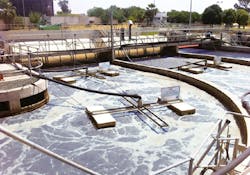Zeev Fisher is vice president, marketing and business development for Mapal Green Energy. Fisher can be reached at [email protected].
The leading challenge faced today in water and wastewater treatment is the ability to save and create efficient energy consumption, which is an essential component in the operational and maintenance expenditure of water and wastewater treatment plants. Energy savings combined with an innovative financial model results in a winning, advanced solution.
This combined solution recently was implemented by Mapal Green Energy, an Israeli wastewater treatment technological company, at the Ramat Hasharon Wastewater Treatment Plant (WWTP) in the center of Israel. Ramat Hasharon is a municipal WWTP with a waste activated sludge process. The WWTP has two Orbal biological reactors and is operated by the R.G.A Group, a company specializing in a wide variety of ecological and municipal services.
The Ramat Hasharon plant treats 3.5 million cubes of water annually. The majority of the treated water is transferred to the Yarkon River in the city of Tel, and the remainder is designated to agricultural irrigation. The plant is one of the first in Israel that follows the water quality regulatory requirements of the governmental Inbar committee that implemented the European Union requirements and determines new standards for the quality of treated water. The plant is active in the “Yarkon Restoration” program to restore treated wastewater to the Yarkon (contaminated for many years) with a higher-quality standard than the present.
R.G.A. Group faced high energy costs due to high electricity consumption for the operation of the WWTP. The process in the plant was based on mechanical aerators. The challenge for Mapal was to provide at least the same results in terms of water quality, but with a significant reduction of energy consumption and costs. Also, the surface aerators had to be replaced with a new system without interrupting the WWTP process or having to drain the reactor.
Energy-Saving Technology
In general, Mapal’s system can reduce up to 70% of the energy consumption in WWTPs and up to 80% of the maintenance costs. The fine-bubble aeration method uses modular floating units that are leveled from the water surface instead of fixed to the concrete floor of the reactor. The floating system saves energy by using fine-bubble aeration instead of mechanical surface aerators. There is no need to build a new and expensive reactor with a concrete floor because the system uses the water as a leveled surface and it is a complete floating system.
The installation in Ramat Hasharon was done live, with no interruption to the process and no risk for the client. No draining of the reactor was required; the same is true in case of any maintenance work (e.g., replacing the fine-bubble diffusers when needed).
Mapal’s technology makes it possible to upgrade any WWTP—from every scale of operation and size, existing or new, concrete basins or excavated lagoons. It also prevents the need to build new concrete reactors. When a WWTP decides to upgrade its aeration system from mechanical surface aeration, it has two options: to stop the process for up to several months in order to drain the reactor for the installation, or to build a new reactor, which is a major capital expenditure investment.
The installation of Mapal’s system is done live in the existing reactor, with no interruption to the process or the daily operation of the plant. As opposed to conventional methods, the system prevents the flow of untreated wastewater from reaching and contaminating the surrounding environment during shutdown for maintenance works or upgrade periods.
Ramat Hasharon Results
The installation of the fine-bubble aeration system at Ramat Hasharon WWTP yielded the following results:
• Energy consumption decreased by 55%;
• Minimal maintenance costs are accrued due to having no moving parts in the water;
• A significant improvement in odor control (no aerosols); and
• Due to the success, the client intends to expand the system to a second reactor in the WWTP.
Financial Model
The unique design of the floating fine-bubble aeration system ensures low operation and maintenance costs in terms of energy consumption and low maintenance needs. Mapal was able to implement a new financial model offering end-users, integrators and WWTP owners its system with no need for investment on their behalf.
The model is based on energy efficiency: In Mapal’s case, the system saves up to 70% of energy consumption. Instead of selling the technology, the company shares profits from energy costs savings with the client.
“Operating the WWTP requires a large amount of energy, especially when infusing oxygen to the water as part of the treatment process,” said Roby Vanono, chairman of R.G.A. Group. “The decision to choose Mapal’s system allowed us to significantly reduce the costs of electricity consumption while maintaining high water quality, which ensures treated water for agriculture and the Yarkon River.”
“The new financial model that Mapal developed enabled the R.G.A. Group to upgrade their WWTP with no financial investment required,” said David Azouri, CEO of Mapal. “Mapal installed the system without expenses for the client, and both companies share the profits derived from energy savings—estimated by at least 50% of the electricity consumption. This model is suitable only for systems that obtain proven significant savings.”
The successful performance of the floating fine-bubble aeration system, both in process improvement and in terms of proven energy savings, will open new opportunities for WWTPs worldwide. To date, the technology has been proven in 25 WWTPs in Israel and abroad, with more contracts in the final signing stage.
Download: Here


